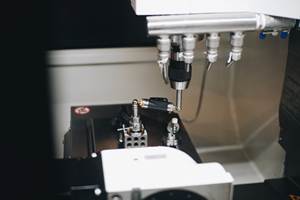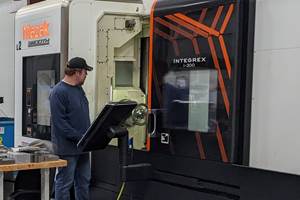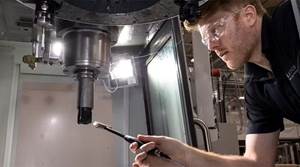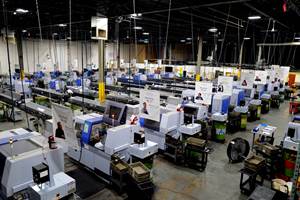New Twist In VMCs
New Twist In VMCs. With their new machine, Monarch has redesigned the traditional VMC table.
Share





Every once in a while, a new variation on an old machine tool theme comes along. An example is a new vertical machining center being introduced by Monarch Machine Tool [now Genesis Worldwide] (Cortland, New York). It's called the PMC-V750.
On a traditional C-frame vertical machining center, the worktable is supported by a set of X- and Y-axis ways resting on the machine base. These axes work together to position the table under the Z-axis fed spindle for metalcutting operations.
With their new machine, Monarch has redesigned the traditional VMC table. A T-shaped cast iron base carries the moving components. The "tail" of the "T" supports an infed column. A set of ways, mounted perpendicular to the floor, runs across the face of the "T."
The worktable (X axis) mounts on 90- degree angular braces. It travels left and right of the spindle, across the face of the machine base. A set of Y-axis ways supports the column and feeds it perpendicular to the table. Z-axis spindle feed is carried on a set of column mounted ways.
There is no stacking of axes. All three are independent and all use linear guide way systems--the first such application on a machining center by Monarch.
Rather than support the worksurface from underneath like traditional vertical design, it is held on either end. For standard 3-axis machining applications the worktable is fixed. If a shop wants fourth-axis capability, a rotary indexer is mounted to opposite ends of the worktable. In effect this arrangement creates a trunnion mount for the table. The worktable is then free to rotate a full circle.
Traditionally, to enhance a C-frame design for fourth-axis capability, a rotary device is added to the worktable of the machine. It may hold a workpiece on a face plate or, for longer work, support it between centers. These devices may provide just positioning or full contouring capability. Regardless, the idea is to make more surfaces of the part accessible to the spindle thereby reducing the need to refixture a workpiece.
Rather than mount an indexer on the table, the new design in effect builds fourth-axis contouring or positioning into the machine. No Z-axis stroke is lost. A fifth axis is also easily integrated into this machine design.
The T-shaped bed design solves several problems inherent in traditional C-frame machines. On most verticals, operators must reach over the machine base that supports the worktable to load or fixture parts. With this new machine design, an operator can literally "belly-up" to the worktable. And, without the base extension, out in front of the machine, floor space requirements are reduced.
Chip evacuation is another nagging problem for verticals. Since the entire work surface of the PMC-V750 can be rotated, with the fourth-axis rotary package, accumulated chips can be dumped by simply turning the table up side down. A CNC command executes the move and can be programmed as often as needed during a machining cycle. A chip conveyor locates below the worktable and carries chips away from the machine
The PMC-V750 is designed for production. Heavy milling is a forte, with a No. 50 taper spindle driven by a 35 hp motor. Spindle speeds range from 30 to 8,000 rpm and are delivered by a two-speed gearbox. The spindle is intercooled to control thermal growth. It is also available with high-pressure coolant option, up to 1300 psi through the tool.
But this is no ponderous machine tool. A benefit of the independent slide system is reduced mass for each axis. This results in quick motion response, such as zero to a top linear feed of 1,180 ipm in 150 milliseconds. Chip-to-chip tool interchange time of five seconds gets the machine back into the cut fast. Up to 40 tools can be stored in the toolchanger.
Ballscrews are cooled to within one degree of ambient and help deliver a repeatability of ¤0.00008 inch in all three axes. The machine is available with two CNC options, either a GE/Fanuc 16MB or a Siemens 840D.
PMC stands for production machining center. It also represents a step forward in vertical machining center design generally by eliminating some of the problems inherent in traditional C-frame machines. With the ease of access and versatile fourth-axis capability, it's truly a new twist in vertical machining centers with potential applications across many industries.
Related Content
Ballbar Testing Benefits Low-Volume Manufacturing
Thanks to ballbar testing with a Renishaw QC20-W, the Autodesk Technology Centers now have more confidence in their machine tools.
Read More5 Tips for Running a Profitable Aerospace Shop
Aerospace machining is a demanding and competitive sector of manufacturing, but this shop demonstrates five ways to find aerospace success.
Read MoreHow to Mitigate Chatter to Boost Machining Rates
There are usually better solutions to chatter than just reducing the feed rate. Through vibration analysis, the chatter problem can be solved, enabling much higher metal removal rates, better quality and longer tool life.
Read MoreInside the Premium Machine Shop Making Fasteners
AMPG can’t help but take risks — its management doesn’t know how to run machines. But these risks have enabled it to become a runaway success in its market.
Read MoreRead Next
Machine Shop MBA
Making Chips and Modern Machine Shop are teaming up for a new podcast series called Machine Shop MBA—designed to help manufacturers measure their success against the industry’s best. Through the lens of the Top Shops benchmarking program, the series explores the KPIs that set high-performing shops apart, from machine utilization and first-pass yield to employee engagement and revenue per employee.
Read MoreAMRs Are Moving Into Manufacturing: 4 Considerations for Implementation
AMRs can provide a flexible, easy-to-use automation platform so long as manufacturers choose a suitable task and prepare their facilities.
Read More




















